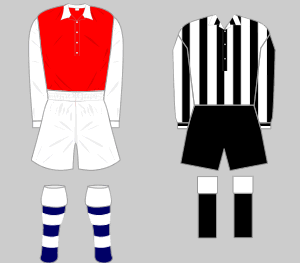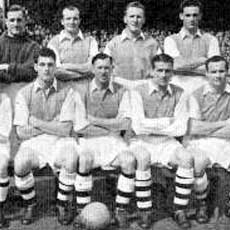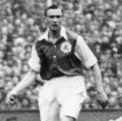Editor’s Note
This piece was originally published on April 8, 2008. For more on the Beatles and soccer, don’t miss “The Beatles FC” at Football and Music.
Every so often, on my perambulations around the footballing part of the internet, I come across a discussion of the Beatles and football: they were Scousers, in their sly way, after all. Were they Liverpool fans? Old Evertonians? Was the Walrus really Dave Hickson? Etc.

The story that usually emerges is that none of the Beatles (George Best included) was particularly devoted to football. There are anecdotes about Paul McCartney listening to FA Cup finals while drifting on his yacht in the Caribbean, but they all have a funny-hats, drinks-with-umbrellas, let’s-make-a-day-of-it sort of ambiance. The best evidence of this is that the stories vary depending on which former intimate friend of Pete Best is being interviewed: there’s the red-and-white scarf in Help!, but Paul’s second cousin was a legend at Goodison, man. “There are three teams in Liverpool, and I prefer the other one,” George Harrison once said. Still, it can’t hurt to sort through the evidence.
The most plausible scenario has Paul leaning toward Everton—there’s a lot of family history tilting in that direction, and he went to the ’68 Cup final—but taking up an interest in Liverpool right around the time that Liverpool happened to become good. It pains me to say it, or actually, it doesn’t pain me to say it, because the man wrote “Eleanor Rigby,” and all your strenuous “fan ethics” didn’t even write “Medicine Jar.” Anyway, Linda used to tell stories of the family sitting back and watching Liverpool eat European Cups fresh off the vine on TV. Paul always had a nose for success.
John, as a boy, probably leaned toward Liverpool. His dad was a fan; and he name-checks Matt Busby (tenuously a Liverpool man in the late ’30s) on “Dig It”; and he was apparently responsible for the wax Albert Stubbins on the cover of Sergeant Pepper. But no one believes that he cared very much.
Like Ray Davies of the Kinks, Ringo was an Arsenal fan in his youth, largely because his Londoner stepfather only took him to Arsenal matches. Ringo’s sons, however, now have season tickets at Anfield, so it’s really anyone’s guess. And the same with George, whose interest in football seems to have waned once he’d finished mining the terrain for his Classic Beatles Quip. Turn left at Greenland!
John Lennon Bonus Coverage: The Walls and Bridges Cover
Every discussion of the Beatles and football notes that the cover of John Lennon’s 1974 album Walls and Bridges shows a picture of a football match that Lennon painted at age 11. To the scholarly football fan it’s probably obvious what the painting depicts, but I’ve never seen it stated online, and the Lennon biographies say only that it’s a painting of “football” (okay, thanks). So I thought I’d jot this down, just so the facts were represented somewhere on…the internet.
Here’s the cover. What’s it all about?

Almost certainly: the 1952 FA Cup final between Arsenal and Newcastle, which Newcastle won 1-0.
The kits are not mysterious, and we can confirm them on Historical Football Kits:

l-r: Arsenal and Newcastle, 1952
The Arsenal kit in Lennon’s painting shows a white badge or crest on the chest that isn’t represented on the historical kit above, or in Arsenal’s 1951-52 squad photo:

But it is represented in photos of Arsenal in the Cup final, suggesting that it could have been added specially to mark the occasion:

In addition to the crest, the date of the painting comes in strongly for the Cup final theory. Lennon dated the painting June 1952, which was just a month after the match took place. The Cup final was the last match he could have seen—or seen a picture of—before he took out his watercolor kit.
Speaking of pictures, here’s one from the game that’s not too far removed from the action on Lennon’s painting.

More John Lennon Bonus Coverage: Revolution #9
The significance of the painting for the adult Lennon was probably that the Newcastle footballer with his back to us is wearing the #9 shirt, and Lennon had a thing for the number nine: “Revolution 9,” “The One After 909,” and “#9 Dream,” which was on Walls and Bridges, in fact. It’s probably just a coincidence that Newcastle’s #9 in 1952 was Jackie Milburn, “Wor Jackie,” one of Newcastle’s greatest players, who scored 177 goals for the club between 1943 and 1957. Still, it’s a neat coincidence, especially for a history-loving football fan who really likes Walls and Bridges. (I am that person. That’s me.) It’s Jackie Milburn who’s getting his header stopped in the photo above, incidentally.
Is it possible that the young John Lennon cared more about football than anyone has realized? He painted a picture of one of the great English footballers of his era in an FA Cup final that didn’t include Liverpool, and took care to get every detail of the kits right, down to Arsenal’s long collar points.
Also: why wasn’t the internet able to tell me that Jackie Milburn was on the cover of a John Lennon solo album? Isn’t that the whole point of the internet? Will you please go tell Wikipedia?
Read More: Arsenal, Beatles, Everton, FA Cup, Liverpool, Newcastle
by Brian Phillips · December 8, 2010
[contact-form 5 'Email form']